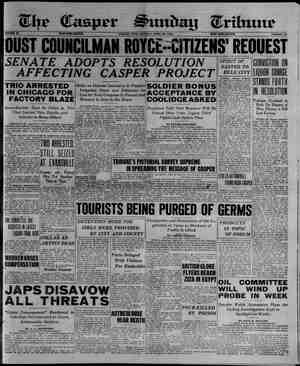Evening Star Newspaper, April 20, 1924, Page 86
You have reached the hourly page view limit. Unlock higher limit to our entire archive!
Subscribers enjoy higher page view limit, downloads, and exclusive features.
THE SUNDAY STAR, WASHINGTON, Do o GRAVURE SECTION APRIL 20, 1924, in the Holy Land B Vit News Pictures, Calvary, where Christ died, is a disputed spot in Jerusalem. Here, how- K 3 z N In ancient Lydda, or Ludd, the scene of one of St. Peter's miracles—the ever, is the site selected by ecclesiastics, and one of the chapels of the Church ! - cure of a palsied invalid. It is midway between Jerusalem and Jaffa, on the of the Holy Sepulcher covers the ground. Near the same spot, according to - 3 i . Mediterranean, and is frequently mentioned in the Old Testament. an old legend, the skull of Adam was found. N : 3 > Christianity's most sacred shrine in the Holy Sepulcher Church of Jerusalem—built over the burial place of the Savior. The tomb is entered through the doorway shown in the photograph. The church was built by Constantine the Great. Roman emperor, in the fourth century. It was destroyed by the Caliph Hakim in 1010 and rebuilt by the First Crusaders in 1099. The Church of the Nativity at Bethlehem covers several sites connected with the life of the Savior. This basilica was built by Constantine the Great, A.D. 330. When this part of Palestine fell into Moslem hands, the church was partly destroyed, but it was restored by Justinian about A.D. 550 The manger at Bethlehem, where Christ was born. It is now a shrine in one of the grottces of the Church of the Nativity. The timber in the foreground is said to be part of the manger’s construction. Tower of David, Jerusalem, near the Jaffa gate in the northwestern part cf the “City of David” district. It is believed to be part of the original castle or walls erected by David when he wrested Jerusalem—then known as Zion or Jebus—from the Jebusites. Archeologists disagree as to the location of the original construction. Bethsaida, on the Sea of Galilee, which figures promi- nently in the New Testament. It was the home of Peter, Andrew and Philip, and it was near here that the multi- tude was fed with the loaves and fishes. One of the rolling stone tombs in the cliffs around Jerusalem. Persons of wealth and position had their burial tombs hewn in the limestone, with rolling stones for doors. It was in such a grave as this one that Christ's body was placed—just such a stone was rolled away the morning of the first Easter.

